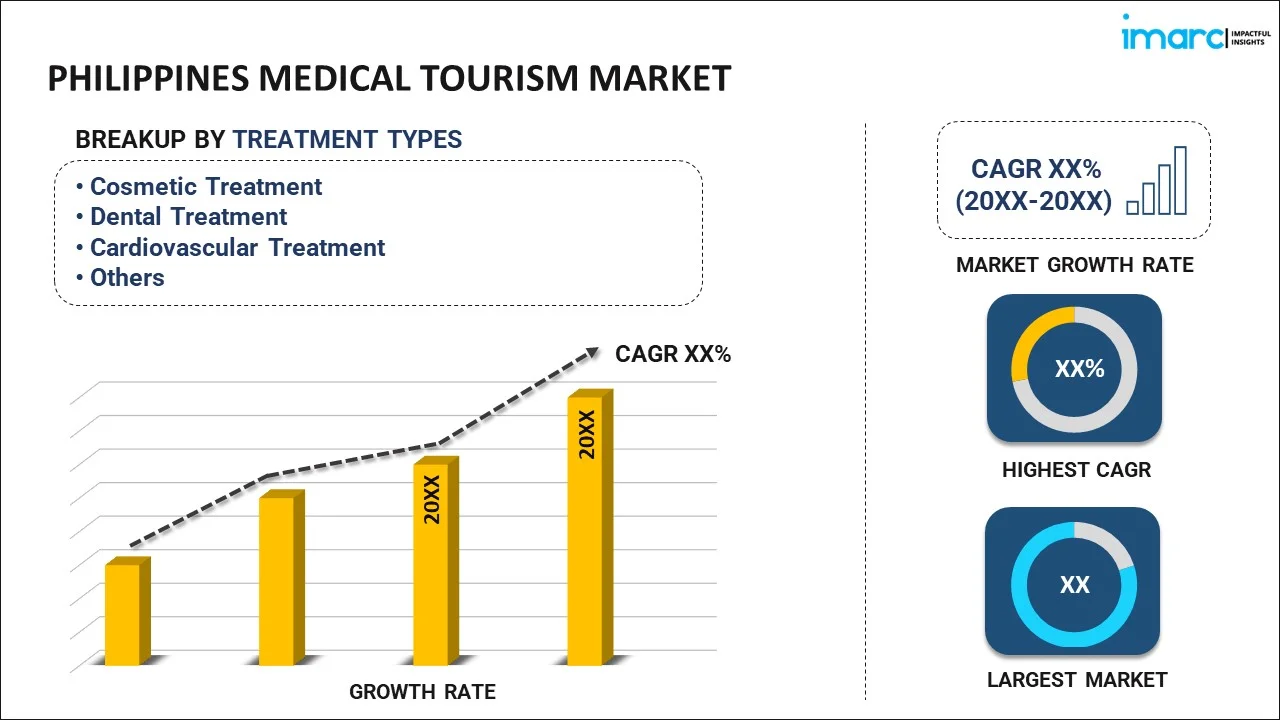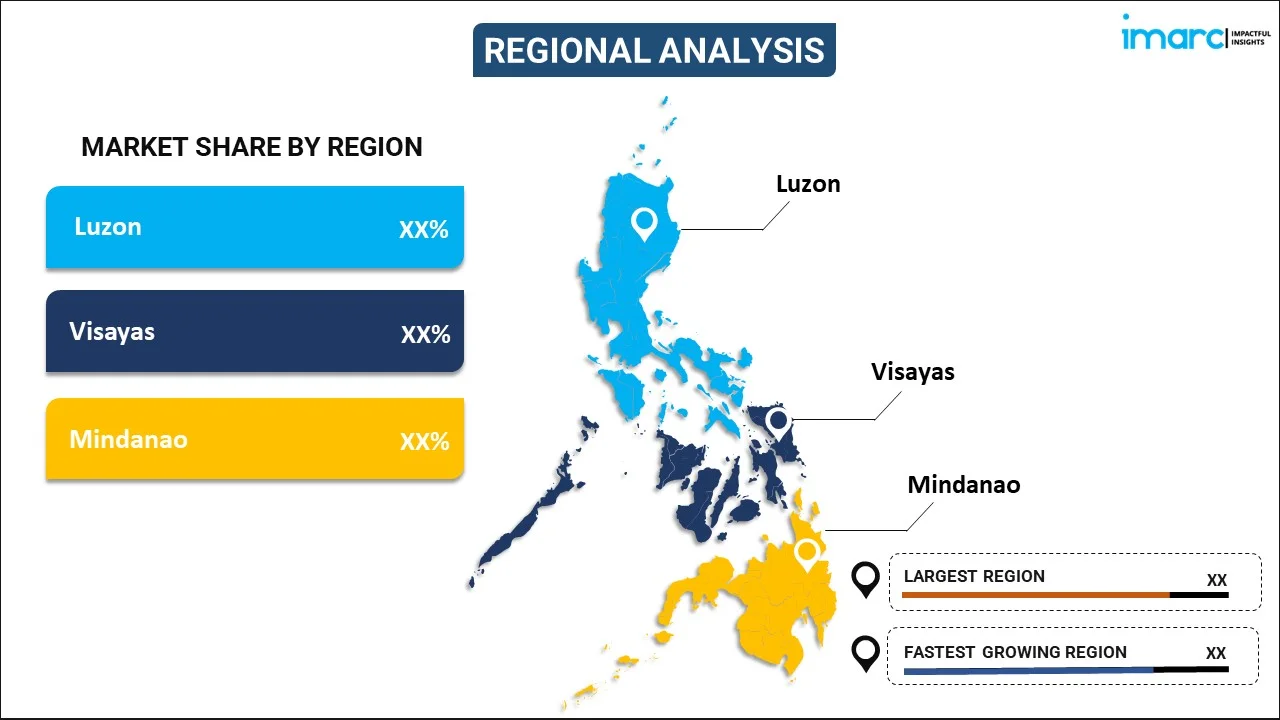
Philippines Medical Tourism Market Report by Treatment Type (Cosmetic Treatment, Dental Treatment, Cardiovascular Treatment, Orthopaedic Treatment, Bariatric Surgery, Fertility Treatment, Ophthalmic Treatment, and Others), Service Provider (Public, Private), and Region 2025-2033
Philippines Medical Tourism Market Overview:
The Philippines medical tourism market size reached USD 1.5 Billion in 2024. Looking forward, IMARC Group expects the market to reach USD 4.8 Billion by 2033, exhibiting a growth rate (CAGR) of 12.83% during 2025-2033. The market is driven by the support of governing agencies to enhance eHealth like telemedicine and teleconsultation, along with aging population, which needs improved healthcare services, such as medical procedures, therapies, and long-term care.
|
Report Attribute
|
Key Statistics
|
|---|---|
|
Base Year
|
2024 |
|
Forecast Years
|
2025-2033 |
|
Historical Years
|
2019-2024
|
| Market Size in 2024 | USD 1.5 Billion |
| Market Forecast in 2033 | USD 4.8 Billion |
| Market Growth Rate (2025-2033) | 12.83% |
Philippines Medical Tourism Market Trends:
Government Support to eHealth
An article published in 2024 on the website of the International Trade Administration (ITA) shows that the Philippine House of Representatives approved “eHealth System and Services Act” to make healthcare data accessible for evidence-based decision-making. eHealth initiatives, like as telemedicine and teleconsultation, allow patients in remote places or even other nations to receive healthcare services from Filipino medical professionals. This improved accessibility entices people who might otherwise be unable to travel for medical treatment. Healthcare professionals in the Philippines can improve patient care by embracing technology. Electronic health records (EHRs) enable more efficient and accurate patient data management, resulting in better diagnostic and treatment outcomes. This improved standard of service helps to strengthen the country's reputation as a dependable medical tourism destination. eHealth solutions streamline several parts of the patient experience, including appointment scheduling and follow-up consultations. This efficiency improves the overall patient experience and makes it easier for medical tourists to access healthcare services in the country.
Telemedicine and other eHealth services can help people save money on healthcare since they eliminate the need for traditional in-person consultations that require travel and lodging. This cost-effectiveness makes medical tourism in the Philippines even more appealing to patients looking for economical healthcare options. The government's support for eHealth initiatives helps promote medical tourism in the Philippines. By emphasizing the country's strong healthcare infrastructure and technology capabilities, the government can attract more overseas patients looking for high-quality care at affordable prices.
Aging Population Growth
According to an article published in 2024 on the website of the Philippine Statistics Authority (PSA), people aged 60 years old and over made up 9.3%, accounting for 166,678 individuals in 2020. As people are aging, there is often a greater need for healthcare services, such as medical procedures, therapies, and long-term care. This rising demand may place a strain on the local healthcare system, prompting some people, particularly those seeking specialist or fast care, to consider medical tourism choices. With an aging population, there may be an increased demand for specialist geriatric care and services. While the Philippines may have facilities and competence in geriatric care, medical tourists from other nations with limited access to such services may be drawn to the Philippines for their knowledge in this field. The demand created by an aging population might encourage investments in healthcare infrastructure and services suited to the needs of the elderly.
As people are getting older, they tend to put more emphasis on their health and wellness. The Philippines, with its natural beauty, wellness resorts, and traditional medicinal traditions, has the potential to attract older people seeking renewal, relaxation, and holistic treatment. Some retirees may contemplate relocating to nations, such as the Philippines for retirement, because of the reduced cost of living, nice climate, and access to decent healthcare.
Philippines Medical Tourism Market News:
- May 2024: St. Luke’s Medical Center, a trailblazer in state-of-the-art healthcare technology in the Philippines, introduced the da Vinci Xi robotic system at its Quezon City facility to achieve surgical excellence.
- April 2024: MakatiMed Wellness Center and Argao Psych collaborated to fulfill the community’s growing need for basic and extended psychological services.
Philippines Medical Tourism Market Segmentation:
IMARC Group provides an analysis of the key trends in each segment of the market, along with forecasts at the country level for 2025-2033. Our report has categorized the market based on treatment type and service provider.
Treatment Type Insights:

- Cosmetic Treatment
- Dental Treatment
- Cardiovascular Treatment
- Orthopaedic Treatment
- Bariatric Surgery
- Fertility Treatment
- Ophthalmic Treatment
- Others
The report has provided a detailed breakup and analysis of the market based on the treatment type. This includes cosmetic treatment, dental treatment, cardiovascular treatment, orthopaedic treatment, bariatric surgery, fertility treatment, ophthalmic treatment, and others.
Service Provider Insights:
- Public
- Private
A detailed breakup and analysis of the market based on the service provider have also been provided in the report. This includes public and private.
Regional Insights:

- Luzon
- Visayas
- Mindanao
The report has also provided a comprehensive analysis of all the major regional markets, which include Luzon, Visayas, and Mindanao.
Competitive Landscape:
The market research report has also provided a comprehensive analysis of the competitive landscape. Competitive analysis such as market structure, key player positioning, top winning strategies, competitive dashboard, and company evaluation quadrant has been covered in the report. Also, detailed profiles of all major companies have been provided.
Philippines Medical Tourism Market Report Coverage:
| Report Features | Details |
|---|---|
| Base Year of the Analysis | 2024 |
| Historical Period | 2019-2024 |
| Forecast Period | 2025-2033 |
| Units | Billion USD |
| Scope of the Report | Exploration of Historical and Forecast Trends, Industry Catalysts and Challenges, Segment-Wise Historical and Predictive Market Assessment:
|
| Treatment Types Covered | Cosmetic Treatment, Dental Treatment, Cardiovascular Treatment, Orthopaedic Treatment, Bariatric Surgery, Fertility Treatment, Ophthalmic Treatment, Others |
| Service Providers Covered | Public, Private |
| Regions Covered | Luzon, Visayas, Mindanao |
| Customization Scope | 10% Free Customization |
| Post-Sale Analyst Support | 10-12 Weeks |
| Delivery Format | PDF and Excel through Email (We can also provide the editable version of the report in PPT/Word format on special request) |
Key Questions Answered in This Report:
- How has the Philippines medical tourism market performed so far and how will it perform in the coming years?
- What has been the impact of COVID-19 on the Philippines medical tourism market?
- What is the breakup of the Philippines medical tourism market on the basis of treatment type?
- What is the breakup of the Philippines medical tourism market on the basis of service provider?
- What are the various stages in the value chain of the Philippines medical tourism market?
- What are the key driving factors and challenges in the Philippines medical tourism?
- What is the structure of the Philippines medical tourism market and who are the key players?
- What is the degree of competition in the Philippines medical tourism market?
Key Benefits for Stakeholders:
- IMARC’s industry report offers a comprehensive quantitative analysis of various market segments, historical and current market trends, market forecasts, and dynamics of the Philippines medical tourism market from 2019-2033.
- The research report provides the latest information on the market drivers, challenges, and opportunities in the Philippines medical tourism market.
- Porter's five forces analysis assist stakeholders in assessing the impact of new entrants, competitive rivalry, supplier power, buyer power, and the threat of substitution. It helps stakeholders to analyze the level of competition within the Philippines medical tourism industry and its attractiveness.
- Competitive landscape allows stakeholders to understand their competitive environment and provides an insight into the current positions of key players in the market.
Need more help?
- Speak to our experienced analysts for insights on the current market scenarios.
- Include additional segments and countries to customize the report as per your requirement.
- Gain an unparalleled competitive advantage in your domain by understanding how to utilize the report and positively impacting your operations and revenue.
- For further assistance, please connect with our analysts.
 Inquire Before Buying
Inquire Before Buying
 Speak to an Analyst
Speak to an Analyst
 Request Brochure
Request Brochure
 Request Customization
Request Customization




.webp)




.webp)












